Can you have a good home gym in an apartment? What are the problems and how can you build it the right way? Here’s what you need to know.
Building a home gym in an apartment is very possible but there are some things to consider specifically in an apartment. The total weight of a home gym has to be limited since apartments aren’t made to handle very heavy loads. Noise and vibrations will also be quite audible to neighbors.
In some ways building a home gym in an apartment is very similar to a garage gym. However, in other ways, you have to keep very different things in mind which will change how you build it. Below you can find out how it is different and how to do it right.
Contents
- 1 Is an Apartment Home Gym Possible?
- 2 Potential apartment gym problems
- 3 Limiting potential apartment gym problems
- 4 Best Apartment Small Exercise Equipment
- 5 Apartment gym setup #1: Resistance bands
- 6 Apartment gym setup #2: Multi-gym
- 7 Apartment gym setup #3: Adjustable dumbbells and bench
- 8 Apartment gym setup #4: Short barbell +Squat stands + Bench
- 9 Apartment gym setup #5: Kettlebells
- 10 Cardio machines for an apartment
- 11 All-in-one multi gym
- 12 Apartment gym no-no’s
Is an Apartment Home Gym Possible?
To find out how you can build a home gym that works for you in your apartment, it’s important to choose the type of workout you want to perform before you start buying equipment.
There are three main types of home gym. Within those types there are variations but choosing the right type from the start will set you on the right path.
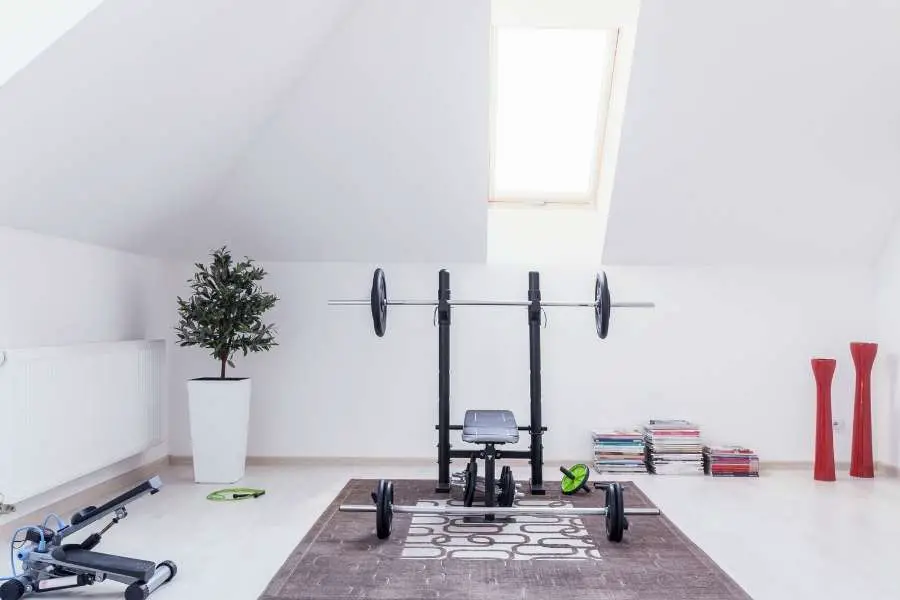
Free Weights
The most popular option is the free weights home gym. That means a gym with barbell, weight plates and/or dumbbells and all the supporting equipment you need to use them.
This type of gym is great for building muscle and general conditioning. Free weights give you a ton of exercise options with a few simple pieces of equipment. With 4 or 5 pieces of equipment you can perform a very complete workout.
It’s also the type of gym that’s likely to cause the most problems in an apartment. Although there are some things you can do to minimize those problems. More on that later.
Cardio
If building muscle is not your priority but weight loss and general fitness is, a cardio machine is what you want. Cardio machines are available in many different varieties. Just pick one that you like. Cardio can be quite boring so picking a type of cardio that you enjoy the most will help you reach your goals.
Don’t worry about one type burning more calories than another. The most effective cardio is the type you do consistently. So if you want to pick something that burns fewer calories per minute but you will do more often, that’s the one to go for.
All in one
If you don’t feel comfortable with free weights but still want to build muscle, an all-in-one home gym is a great solution. You have the safety and benefits of machines without using a lot of space. In a commercial gym, you will see a lot of different machines that are all used to work out one muscle.
In a commercial gym that’s fine because they have the space and actually want more different machines so more people can work out at the same time. In a home gym, you’re just working out alone or maybe with one other person and the space is limited. That’s why an all-in-one machine is a good solution.
There are benefits to free weights for sure but if you prefer the machines, this is a good solution. Most people will know these machines as a ‘Bowflex’ but there are many brands that produce very similar machines in different levels of quality.
Potential apartment gym problems
Now you probably have the type of home gym you want in mind. So with that knowledge it’s time to get to some apartment specific problems that arise when planning/building a home gym.
Building a home gym in an apartment definitely has some problems and different considerations than a garage for example.
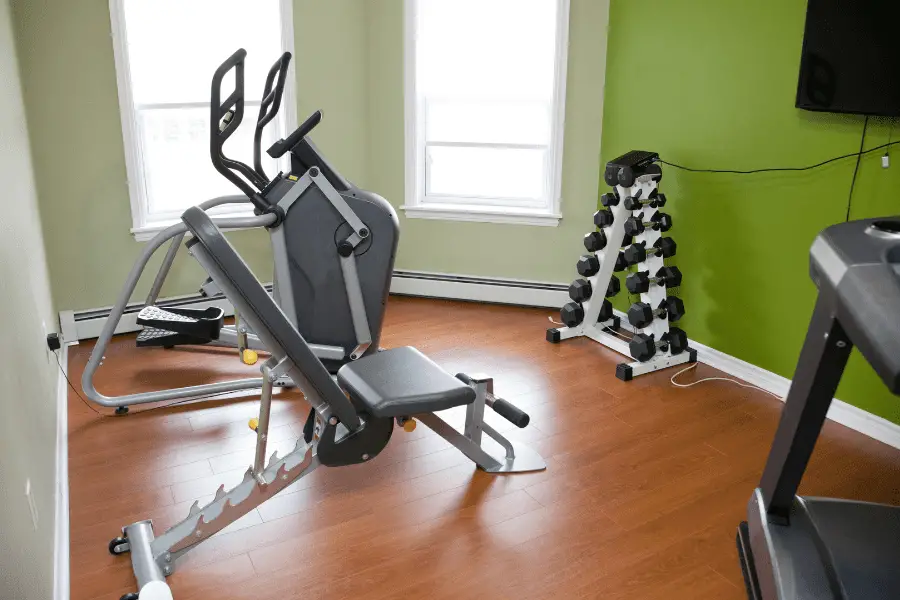
Weight limits
The biggest potential problem of building a home gym in an apartment is the weight limit of the floor. Most home gyms will be built in a garage or basement. Those locations (especially the garage) are built to withstand high weights of a car or truck so a home gym isn’t a problem. If you would exceed the weight limit of the floor there, you can’t really fall down.
An apartment is very different in that way. You have another apartment under you so you might be a bit worried about the floor. And that’s a good thing to worry about. Apartments are built for normal living with good safety margins. They aren’t really built with very heavy loads in mind.
WARNING: I am not in any way certified to advise you how much weight your floor can handle. That’s why I’m not going to give you any numbers of how much weight you can put in your apartment. Building codes are different in every state and country. If you want to know what’s possible in your apartment, get professional advice from a building inspector or otherwise qualified person.
Use some common sense and know that an apartment floor will not support the same kind of weight a garage floor would. Building codes will usually list static weight limits. When moving weights, they have more force so if your apartment has a 150 kg per square meter weight limit, dropping a 150 kg barbell from hip height is going to exert much more force on your floor which it might not be able to handle.
Noise
Working out makes noise one way or another. Lifting weights is the biggest noise producer from the setups listed above. It’s not the lifting of the weight that makes much noise (unless you’re a grunter). It’s the weights returning to the floor or rack that makes the noise. Re-racking a weight is usually done relatively carefully so it creates less noise than dropping the weights on the floor.
Dropping weights on the floor is almost like hitting the skin of a drum. It will cause vibrations which are audible. A lot of noise will come directly from the impact of the weights on the floor but the resulting vibrations in the floor will also create a lot of lower frequencies.
And don’t think this is Olympic style dropping from overhead or even just from hip height. Doing that is completely out of the question. By doing that with decent weights, you have a good chance of exceeding weight limits (weight limits are set for static weight, not moving) and you’ll definitely piss off the neighbors.
What I mean is how you set down a deadlift relatively controlled for example. Or letting the dumbbells go after a set of presses. Even that speed of impact will produce a considerable amount of noise.
If anything is going to piss off your neighbors, this is it.
Vibrations
Another potential problem is vibrations. Sure, sounds are also vibrations but what I mean here is the vibrations you don’t really hear but feel. These are potentially more problematic because over time vibrations can loosen things.
Your downstairs neighbors probably don’t enjoy the lamps swinging from the ceiling and dust raining down on them.
The causes of this are the same as the noise above because they are pretty much the same thing. Vibrations you can’t hear are usually just too low a frequency to be audible by humans.
Regulations
A big part of what you can do in an apartment is not only limited by physical limitations but also largely by rules and regulations set by your landlord or homeowner association.
Most landlords and HOA’s probably won’t set a hard rule against home gyms but most of them might not be too excited by the idea.
Check your regulations of the apartment you live in before you do anything. You don’t want to get into more trouble than it’s worth.
Space
Apartments tend to be smaller than houses. Of course there are always exceptions but that’s generally the case. That means you might not be able to build the ultimate home gym of your dreams. However, if you’ve got a 10’ by 10’ free space, you can still build a pretty effective and complete home gym.
Suggested post: How much space do you need for a home gym?
Limiting potential apartment gym problems
Above you can see there are some potential problems with building a home gym in an apartment. After reading all of those you might think I’m not recommending to build a home gym in an apartment. That’s not quite true. There are problems but with some careful planning, knowledge and common sense you can still have a functional home gym. What can you do to limit those problems and enjoy the home gym you want?
Plan
Plan what kind of home gym you want to build with the potential problems above in mind. Most of those problems are relatively easily mitigated with some good planning. Picking the right equipment for the job and knowing how to minimize before you start buying/building is always the best first step.
More on equipment selection later.
If you need some help planning your home gym, I’ve got a beginner friendly manual that shows you exactly how to build a home gym in a small space. Check it out here.
Limit the weight
The biggest problem or at least the thing with the worst potential results is the weight of the home gym. The weight plates and dumbbells are obviously the biggest offenders here.
As long as they’re spread out over the room, it’s unlikely to cause any problems. Stacking all your weight plates on one spot might be a bit of an issue. Try to spread out the weight when possible/practical.
When actually lifting the weight it’s more difficult to spread it out of course. All the weight is going to the floor through your feet. That means a tiny bit of floor is getting all the weight. How much weight your floor can handle is different everywhere because there are different building codes all over the place so make sure to check the code your building was constructed to meet.
As already mentioned above, if you find a number in your building code, it will likely be in lbs. per square foot. That’s static weight. You want to stay well under that number because you’re moving the weights and that exerts more force on the floor.
Also, the floor can handle more weight close to the walls than in the middle of the room. If you’re going to lift very heavy, do so as close to a wall as possible.
If you are afraid you can’t lift the weights you want, take a look at changing your rep ranges. Yes you might have to change your workout program a little but it’s one of the sacrifices you might have to make.
Exercise selection
This is a continuation of the last point. Some exercises are performed much heavier than others. Also, some exercises are more likely to be put down forcefully/uncontrolled. Those are the exercises most likely to cause problems.
The biggest offender is probably the deadlift. The deadlift is usually the heaviest lift a person can do and is often set down uncontrolled. This combination is not a great one for apartments. It means the most amount of force exerted on your floor and the most noise/vibrations created.
It’s probably an exercise you’ll have to take out of your routine if you’re working out in an apartment.
If you really want to deadlift, it’s a good idea to get some deadlift pads to distribute the weights over a bigger area and slow down the impact. Deadlift pads are a great way to dampen the noise and impact of a deadlift. Of course you can also use them for other exercises where the weights hit the floor.
Don’t break any rules or contracts
If the rules of your rental contract or HOA state that anything in this post isn’t allowed. Don’t do it. It isn’t worth getting kicked out or even getting sued for having a home gym.
If the rules are ambiguous, talk about what your plans are and if it’s OK. Make sure there is a paper trail of any approval so you don’t get into trouble later on. Also, before you start talking to your landlord, make sure you have a solid and reasonable plan to show.
If you don’t exactly know what you’re going to do, your landlord is unlikely to like any of it because it’s too ambiguous. Landlords are worried about their property and the other tenants. So showing you’ve got a plan to protect both, you stand a much better chance.
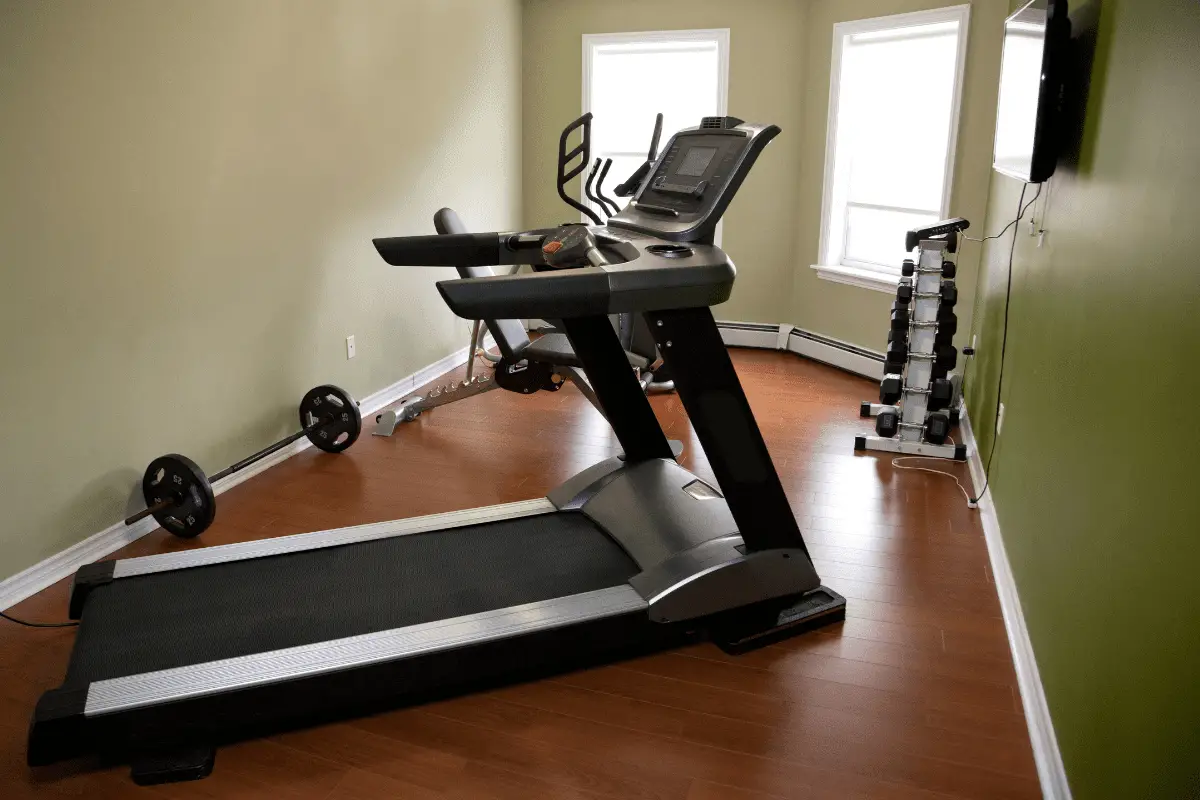
Get the right equipment
There is a lot of different home gym equipment available on the market. That can make it difficult to choose something but on the other hand, you have a lot of options to really get things how you need/want them.
For an apartment home gym there are a few things to consider;
- Size: It should be small enough to fit in the space you have. That’s floor space and height.
- Weight: We want to limit the total weight of the setup. The weight plates and dumbbells are going to be the biggest part of the weight but if we can save some weight in other equipment that helps.
- Noise production/transfer: It’s good to limit the noise and vibrations that are transferred to your neighbors. Having as much as possible wrapped in rubber helps with this.
We’ll go into depth about equipment recommendations below.
Flooring
Gym flooring is important in a garage gym. In an apartment gym it’s much more important. It’s hard to overstate how important the flooring is if you want to work out above the neighbors head.
Keep in mind though that even the best flooring in the world can’t dampen the
The gym flooring doesn’t increase the structural strength of the floor below it in any way. It will disperse the weight a bit more evenly but don’t count on this to be able to overload your floor.
Besides all the usual benefits of gym flooring, you really want the good stuff in your apartment for the following reasons;
- Noise
- Vibrations
Good gym flooring can dramatically reduce the noise and vibrations created by your workout. Heavy rubber mats absorb the noise and transfer fewer vibrations to the floor than without it. Since noise is the biggest concern after weight, flooring plays a big role in minimizing this.
Lower responsibly
Besides having everything rubberized and having great flooring, the biggest way to prevent noise and vibrations is lowering your weights slowly.
The slower the weight hits the floor, the less noise and vibrations are created in the first place. Even the best flooring you can get isn’t as effective as that.
This goes for free weights but also the all-in-one multi gyms with a weight stack. Just prevent anything heavy from hitting the floor (or something standing on the floor) and you’ll prevent a lot of complaints.
This might mean you need to change your style of lifting a little bit.
Besides the noise and vibrations, lowering your weights slower is also a lot safer for your floor. If you put a barbell with 225 lbs. on your floor, there is most likely not going to be a problem. However, if you drop it from space it will probably go through several floors before stopping.
Ok, that’s an extreme example but I think you get the point; weight is amplified by speed. Dropping the same weight from 1 inch height or 2 feet high puts a whole different level of stress on your floors.
If you’re lifting relatively heavy and also dropping the weights, you’re putting yourself and everyone in the building in danger besides it being very noisy.
Training time
Finally, to prevent any complaints, think about the time at which you work out. The great thing about a home gym is that you can use it at any time. However, it’s almost impossible to not create any noise when working out.
That’s why it’s a good idea to find a time to work out where it causes the least amount of headache for your neighbors. What time that is depends on your and their schedule. Does this limit the use of your home gym somewhat? Yes it does, it’s one of the downsides of living in an apartment. You can be a XXXX and not care about your neighbors but that’s probably not going to yield very good long term results.
Best Apartment Small Exercise Equipment
Apartments are usually smaller than houses, you have neighbors to contend with and putting a lot of weight on the floor could pose a problem. So you’re right to research what kind of equipment works to build a home gym in an apartment.
What you want from apartment gym equipment:
- Compact
- Effective
- Not too heavy
- Not too noisy
Below you can see a few different setups that all work very well in an apartment.

Apartment gym setup #1: Resistance bands
The most compact and lightest way to get some workout equipment in your home gym is a set of resistance bands. They are very cheap for what you can do with them and they are effective for building muscle, rehab and improving flexibility.
Go for a complete set of tube bands with handles. Look for a combo set that has; 5 different bands, 2 handles, 2 ankle straps and a door anchor. That is a great starter set that allows you to do a lot of different exercises. You can add some extra mini bands or wall anchors to extend the functionality of the set.
Apartment gym setup #2: Multi-gym
Do you like the machines in the gym? It’s hard to replace all of those machines at home let alone in an apartment. However, there is a piece of home gym equipment that tries to replace as many gym machines as possible. That equipment is called a multi-gym. These multi-gyms come in many different sizes and price ranges but there are certainly some compact options.
The better multi-gyms are larger and more expensive but are also much better. Get the best one you can afford and fit in your apartment.
Almost all multi-gyms have exercise options for arms, chest, back, legs and glutes. You can get a full body workout on a multi-gym in a similar way you can with all the different machines in a commercial gym.
Multi gyms do take up space permanently, you can’t move them. So you need a dedicated space or corner in your apartment to be able to place one of them. Most of them aren’t works of art so you probably don’t want them in the living room.
Apartment gym setup #3: Adjustable dumbbells and bench
Maybe you prefer something a little more like a real free weights gym. Dumbbells and a bench allow you to do many exercises with free weights. A bench is not too big and heavy and it’s pretty easy to push into a corner when not in use. Most benches have little wheels on one end so they’re easy to move around.
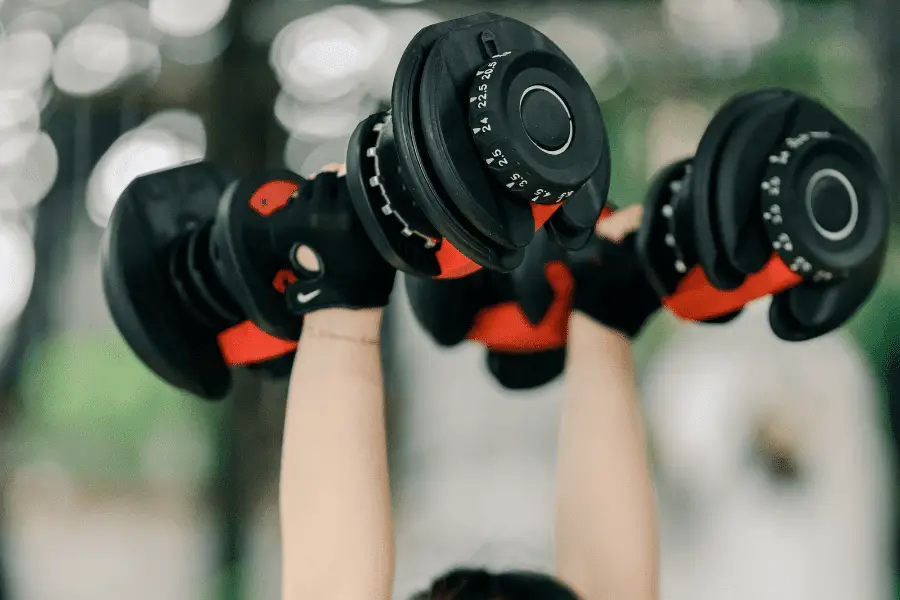
Normal dumbbells are quite expensive and take up a lot of space. Luckily there are adjustable dumbbells. Adjustable dumbbells replace many pairs of dumbbells while just being a single pair. That means they’re cheaper and smaller which is more suitable for an apartment.
There are different types of adjustable dumbbells. The cheap type is just a handle with screw collar. With that type, you have to unscrew the collar and change the plates on the handle yourself. The second type of adjustable dumbbells has a base station and selection mechanism that picks up the amount of weight you set. The second type is far easier to use but more expensive.
Apartment gym setup #4: Short barbell +Squat stands + Bench
Sometimes you just want to work out with a barbell. It’s possible to put a power cage in an apartment. But since we’re talking about small workout equipment, a power cage doesn’t really fit the bill. You’ll still need something to rest the barbell on. You can’t do all barbell exercises when the bar is on the floor. For things like squats and bench presses, you want the bar to be held at the right height.
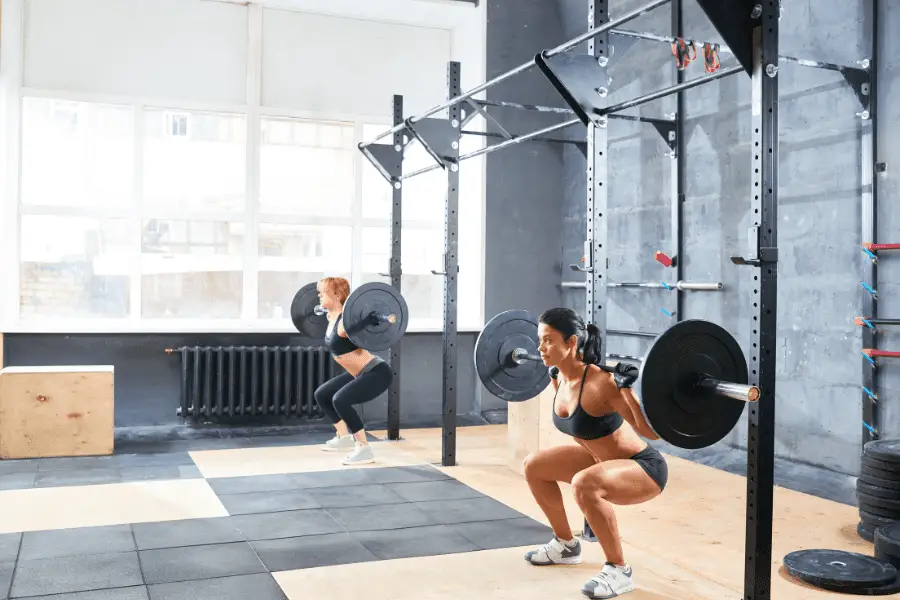
So if a power cage is out of the question, squat stands are a good alternative. Squat stands are two pillars that are often adjustable in height to rest a bar on. Some of the stands are connected (sometimes width adjustable) while others are separate. That means you can use a shorter barbell than you would have to with a power rack. So you could use a 6’ long barbell which is a pretty big space savings over the standard 7’2 bar. Going from a full sized barbell and power cage to short bar and squat stands saves a lot of space.
The downside of squat stands is that they’re less safe. A bolted down squat stand has no chance of toppling over even if you drop 600 lbs. Squat stands don’t have that stability. So if you want to lift really heavy, it’s not a great choice.
A bench expands the use of this setup a lot just like with dumbbells. A bench allows you to do bench presses, incline bench presses, seated overhead presses etc.
Apartment gym setup #5: Kettlebells
Another piece of equipment that can just provide a whole workout are kettlebells. You need two or three kettlebells of different weights to do a full body workout. You don’t really need anything else. Kettlebells can be put in a cupboard pretty easily so you don’t need any permanent floor space. And even if you don’t want them in a cupboard, just put them under a desk or something like that.
A vinyl coated kettlebell helps prevent damage to you floor and reduces noise but a little rubber gym mat is even better. Read more about kettlebells here
Cardio machines for an apartment
The setups above are for muscle and strength building. But what about cardio exercise. No worries, here are the best options. You can easily combine each of these machines with one of the setups above without any issues. As long as you’ve got enough space, there is no reason why it wouldn’t work.
For an apartment you want a cardio machine that’s relatively small, light and is quiet. Cardio machines where there is an impact can transfer a lot of noise and vibrations to other apartments. That means a treadmill is not the best choice for the neighbors. There are ways to minimize the noise (like a good treadmill mat) but it’s hard to get rid of completely. Treadmills are quite large as well.
Better options for an apartment gym are;
- Exercise bike: An exercise bike is the smallest cardio machine. It’s also light so easy to move and effective. You can choose a spin or upright bike for a tough workout or a recumbent bike for a more relaxed, steady state workout. A spin bike only needs a space of about 4’x5’ when in use and much less when not in use.
- Air bike: An air bike is basically an exercise bike but the way of creating resistance is different enough to warrant a separate mention. Click here to find out more about air bikes.
- Rowing machine: A rowing machine is long and narrow. Most of them can be folded up so they do take up quite a bit of space while in use but when folded, they’re pretty compact. Rowing is also a full body exercise that focuses on the back of the body which is really necessary for most people.
Those options above are compact, light and effective. However, in the end, you just want to get the machine you’ll use the most/enjoy using the most. Because one of the biggest parts of getting fit is consistency, you need a cardio machine you’ll actually use.
All-in-one multi gym
All in one multi gyms are a quite interesting alternative to free weights. Not only because many people feel safer using machines than free weights but also because for use in apartments, it can alleviate some of the biggest problems.
There are different types of multi gyms. The most common type has a weight stack. This means there is a stack of weights with holes in them. You put a pin in the hole that lets you pick the weight you want to lift. Via a system of cables and pulleys you can lift the same weight stack in different ways so you can do different exercises. The weight stack always moves up and down. So if you lower that weight stack quickly, you have the same problems as with free weights regarding noise and vibrations.
Here’s where one of the other types is very interesting and that is the Bowflex home gym. Most people will already know Bowflex from cheesy TV commercials. If you’re like me, you will have a natural suspicion of any fitness product that’s advertised on TV but Bowflex actually makes good products for a good price.
The Bowflex home gyms are different because they create resistance in a different way. They don’t have a weight stack but metal rods that bend when you do an exercise. There are different rods with different resistance levels so you can still choose how much resistance you want.
I’m sure you can already see why this is very beneficial in an apartment;
- Rods are much lighter than a weight stack. You can upgrade Bowflex home gyms up to 410 lbs. of resistance while the rods weigh nowhere near that much.
- No banging noise from lowering the weights.
So two of the biggest problems can be solved by going for a Bowflex home gym.
Apartment gym no-no’s
Here are some no-no’s if you’re thinking about building an apartment gym. They are already described above but just to drive the points home, here they are in short form;
- Don’t overload your floor. You’re just putting yourself and everyone else in the building in danger. If you have heavy weights, lift them as close to the wall as possible.
- Don’t produce excessive noise and especially not at times people want to sleep.
- Don’t think it’s impossible to work out and build muscle in an apartment. Just use some common sense and use the right equipment.
